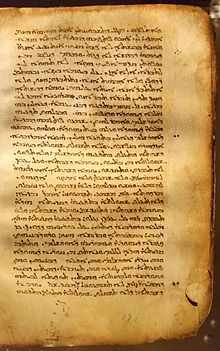Loading AI tools
Standard Syriac Christianity version of the Bible From Wikipedia, the free encyclopedia
The Peshitta (Classical Syriac: ܦܫܺܝܛܬܳܐ or ܦܫܝܼܛܬܵܐ pšīṭta) is the standard version of the Bible for churches in the Syriac tradition, including the Maronite Church,[2] the Chaldean Catholic Church,[3] the Syriac Catholic Church,[4] the Syriac Orthodox Church, the Malankara Orthodox Syrian Church, the Malabar Independent Syrian Church (Thozhiyur Church), the Syro-Malankara Catholic Church, the Assyrian Church of the East and the Syro-Malabar Church.
| Peshitta | |
|---|---|
 9th-century manuscript | |
| Full name | ܡܦܩܬܐ ܦܫܝܛܬܐ mappaqtâ pšîṭtâ |
| Other names | Peshitta, Peshittâ, Pshitta, Pšittâ, Pshitto, Fshitto |
| OT published | 2nd century |
| NT published | 3rd-5th century [1] |
| Translation type | Syriac language |
| Religious affiliation | Syriac Christianity |
ܒܪܵܫܝܼܬܼ ܒ̣ܪܵܐ ܐܲܠܵܗܵܐ ܝܵܬ݂ ܫܡܲܝܵܐ ܘܝܵܬ݂ ܐܲܪܥܵܐ ܘܐܲܪܥܵܐ ܗ̣ܘܵܬ݂ ܬܘܿܗ ܘܒ݂ܘܿܗ ܘܚܸܫܘܿܟ݂ܵܐ ܥܲܠ ܐܲܦܲܝ̈ ܬܗܘܿܡܵܐ ܘܪܘܼܚܹܗ ܕܐܲܠܵܗܵܐ ܡܪܲܚܦܵܐ ܥܲܠ ܐܲܦܲܝ̈ ܡܲܝ̈ܵܐ ܘܐܸܡ̣ܲܪ݂ ܐܲܠܵܗܵܐ: ܢܸܗ̣ܘܸܐ ܢܘܼܗܪܵܐ ܘܲܗ̣ܘܵܐ ܢܘܼܗܪܵܐ
ܗܵܟ݂ܲܢܵܐ ܓܹܝܪ ܐܲܚܸܒ݂ ܐܲܠܵܗܵܐ ܠܥܵܠܡܵܐ ܐܲܝܟܲܢܵܐ ܕܠܲܒ݂ܪܸܗ ܝܼܚܝܼܕ݂ܵܝܵܐ ܢܸܬܸܠ ܕܟ݂ܿܠ ܡ̇ܲܢ ܕܲܡܗܲܝܡܸܢ ܒܸܗ ܠܵܐ ܢܹܐܒ݂ܲܕ݂ ܐܸܠܵܐ ܢܸܗܘܘܼܢ ܠܸܗ ܚܲܝܹ̈ܐ ܕܲܠܥܵܠܲܡ | |
The consensus within biblical scholarship, although not universal, is that the Old Testament of the Peshitta was translated into Syriac from Biblical Hebrew, probably in the 2nd century CE, and that the New Testament of the Peshitta was translated from Koine Greek, probably in the early 5th century.[5][6] This New Testament, originally excluding certain disputed books (2 Peter, 2 John, 3 John, Jude, Revelation), had become a standard by the early 5th century. The five excluded books were added in the Harklean Version (616 CE) of Thomas of Harqel.[7][8][9] The New Testament of the Peshitta often reflects the Byzantine text-type, although with some variations.[10][11]
Peshitta is derived from the Syriac mappaqtâ pšîṭtâ (ܡܦܩܬܐ ܦܫܝܛܬܐ), literally meaning "simple version". However, it is also possible to translate pšîṭtâ as "common" (that is, for all people), or "straight", as well as the usual translation as "simple". Syriac is a dialect, or group of dialects, of Eastern Aramaic, originating around Edessa. It is written in the Syriac alphabet and is transliterated into the Latin script in a number of ways, generating different spellings of the name: Peshitta, Peshittâ, Pshitta, Pšittâ, Pshitto, Fshitto. All of these are acceptable, but Peshitta is the most conventional spelling in English.
The Peshitta had from the 5th century onward a wide circulation in Asia, and was accepted and honored by the whole diversity of sects of Syriac Christianity. It had a great missionary influence: the Armenian and Georgian versions, as well as the Arabic and the Persian, owe not a little to the Syriac. The Nestorian tablet of Chang'an shows the presence of the Syriac scriptures in China in the 8th century.
The Peshitta was first brought to Europe by Moses of Mardin, a noted Syrian ecclesiastic who unsuccessfully sought a patron for the work of printing it in Rome and Venice. However, he was successful in finding such a patron in the Imperial Chancellor of the Holy Roman Empire at Vienna in 1555—Albert Widmanstadt. He undertook the printing of the New Testament, and the emperor bore the cost of the special types which had to be cast for its issue in Syriac. Immanuel Tremellius, the converted Jew whose scholarship was so valuable to the English reformers and divines, made use of it, and in 1569 issued a Syriac New Testament in Hebrew script. In 1645, the editio princeps of the Old Testament was published by Gabriel Sionita for the Paris Polyglot, and in 1657 the whole Peshitta was included in Walton's London Polyglot. An edition of the Peshitta was that of John Leusden and Karl Schaaf, and it is still quoted under the symbol "Syrschaaf", or "SyrSch".
In a detailed examination of Matthew 1–14, Gwilliam found that the Peshitta agrees with the Textus Receptus only 108 times and with the Codex Vaticanus 65 times. Meanwhile, in 137 instances it differs from both, usually with the support of the Old Syriac and the Old Latin, and in 31 instances it stands alone.[12]
A statement by Eusebius that Hegesippus "made some quotations from the Gospel according to the Hebrews and from the Syriac Gospel," means we should have a reference to a Syriac New Testament as early as 160–180 CE, the time of that Hebrew Christian writer. The translation of the New Testament has been admired by Syriac scholars, who have deemed it "careful, faithful, and literal" with it sometimes being referred to as the "Queen of the versions".[13]
The standard United Bible Societies 1905 edition of the New Testament of the Peshitta was based on editions prepared by Syriacists Philip E. Pusey (d. 1880), George Gwilliam (d. 1914) and John Gwyn.[14] These editions comprised Gwilliam & Pusey's 1901 critical edition of the gospels, Gwilliam's critical edition of Acts, Gwilliam & Pinkerton's critical edition of Paul's Epistles and John Gwynn's critical edition of the General Epistles and later Revelation. This critical Peshitta text is based on a collation of more than seventy Peshitta and a few other Aramaic manuscripts. All 27 books of the common Western Canon of the New Testament are included in this British & Foreign Bible Society's 1905 Peshitta edition, as is the adultery pericope (John 7:53–8:11). The 1979 Syriac Bible, United Bible Society, uses the same text for its New Testament. The Online Bible reproduces the 1905 Syriac Peshitta NT in Hebrew characters.
English
Malayalam
Although physical evidence has yet to be found, 18th-century Maronite Orientalist Giuseppe Assemani[15] stated in his Bibliotheca Orientalis that a Syriac Gospel dated 78 CE was found in Mesopotamia.[16][17][18]
The following manuscripts are in the British Archives:
Seamless Wikipedia browsing. On steroids.
Every time you click a link to Wikipedia, Wiktionary or Wikiquote in your browser's search results, it will show the modern Wikiwand interface.
Wikiwand extension is a five stars, simple, with minimum permission required to keep your browsing private, safe and transparent.